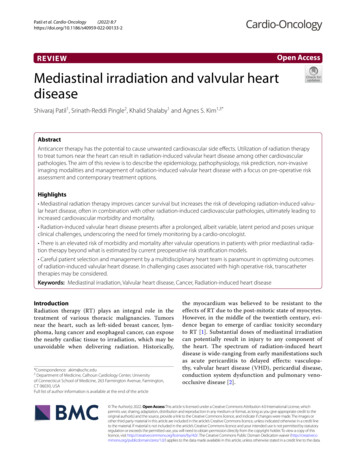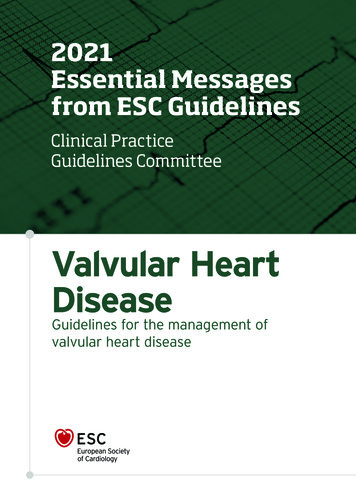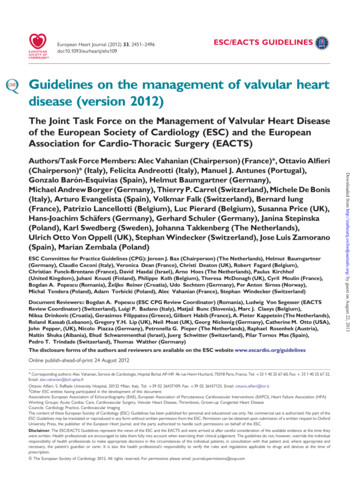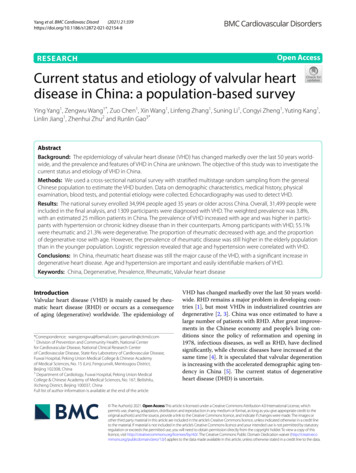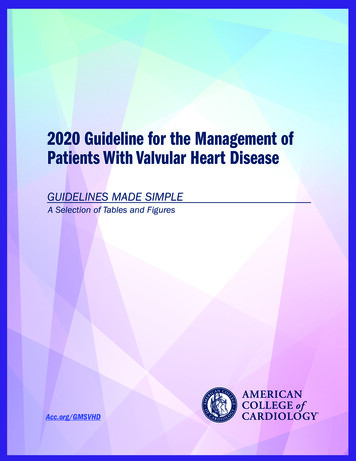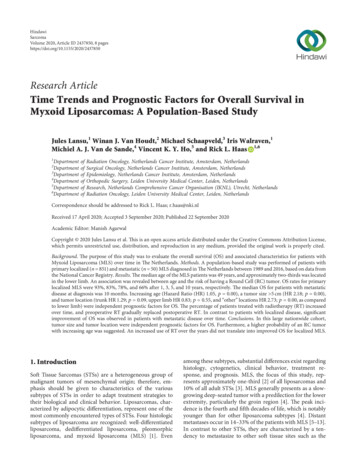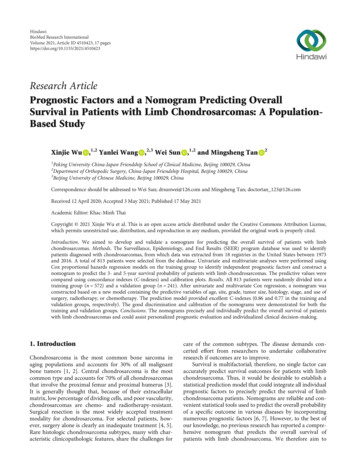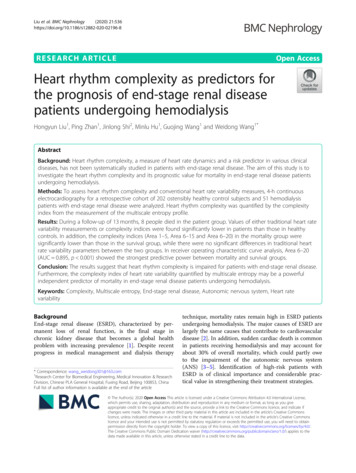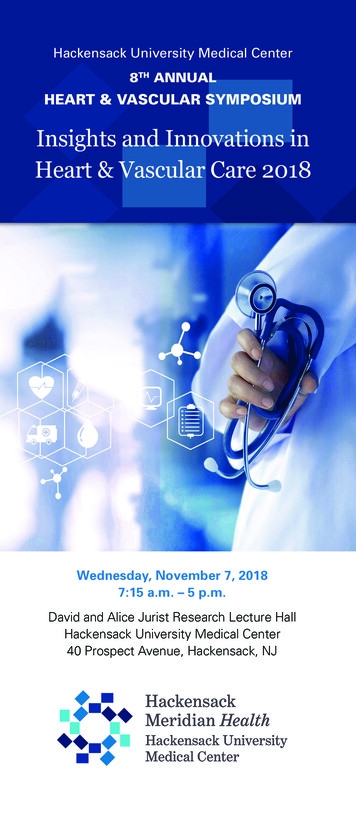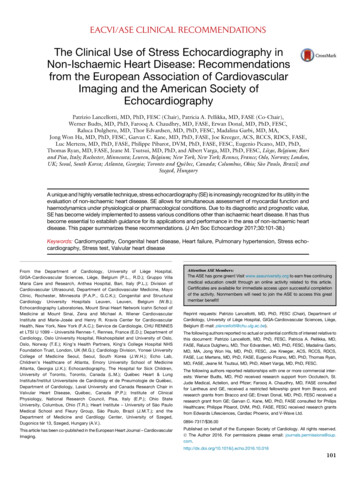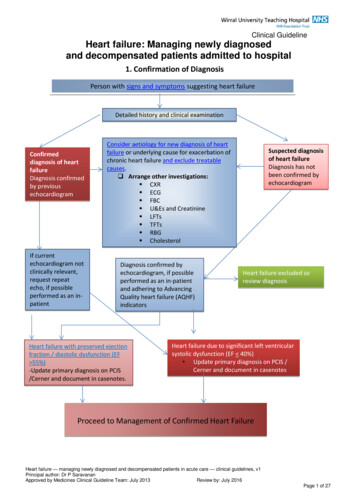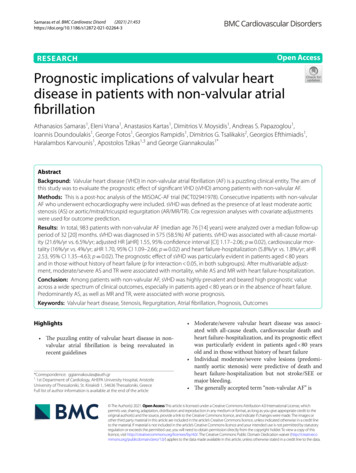
Transcription
(2021) 21:453Samaras et al. BMC Cardiovasc en AccessRESEARCHPrognostic implications of valvular heartdisease in patients with non‑valvular atrialfibrillationAthanasios Samaras1, Eleni Vrana1, Anastasios Kartas1, Dimitrios V. Moysidis1, Andreas S. Papazoglou1,Ioannis Doundoulakis1, George Fotos1, Georgios Rampidis1, Dimitrios G. Tsalikakis2, Georgios Efthimiadis1,Haralambos Karvounis1, Apostolos Tzikas1,3 and George Giannakoulas1*AbstractBackground: Valvular heart disease (VHD) in non-valvular atrial fibrillation (AF) is a puzzling clinical entity. The aim ofthis study was to evaluate the prognostic effect of significant VHD (sVHD) among patients with non-valvular AF.Methods: This is a post-hoc analysis of the MISOAC-AF trial (NCT02941978). Consecutive inpatients with non-valvularAF who underwent echocardiography were included. sVHD was defined as the presence of at least moderate aorticstenosis (AS) or aortic/mitral/tricuspid regurgitation (AR/MR/TR). Cox regression analyses with covariate adjustmentswere used for outcome prediction.Results: In total, 983 patients with non-valvular AF (median age 76 [14] years) were analyzed over a median follow-upperiod of 32 [20] months. sVHD was diagnosed in 575 (58.5%) AF patients. sVHD was associated with all-cause mortality (21.6%/yr vs. 6.5%/yr; adjusted HR [aHR] 1.55, 95% confidence interval [CI] 1.17–2.06; p 0.02), cardiovascular mortality (16%/yr vs. 4%/yr; aHR 1.70, 95% CI 1.09–2.66; p 0.02) and heart failure-hospitalization (5.8%/yr vs. 1.8%/yr; aHR2.53, 95% CI 1.35–4.63; p 0.02). The prognostic effect of sVHD was particularly evident in patients aged 80 yearsand in those without history of heart failure (p for interaction 0.05, in both subgroups). After multivariable adjustment, moderate/severe AS and TR were associated with mortality, while AS and MR with heart failure-hospitalization.Conclusion: Among patients with non-valvular AF, sVHD was highly prevalent and beared high prognostic valueacross a wide spectrum of clinical outcomes, especially in patients aged 80 years or in the absence of heart failure.Predominantly AS, as well as MR and TR, were associated with worse prognosis.Keywords: Valvular heart disease, Stenosis, Regurgitation, Atrial fibrillation, Prognosis, OutcomesHighlights The puzzling entity of valvular heart disease in nonvalvular atrial fibrillation is being reevaluated inrecent guidelines*Correspondence: ggiannakoulas@auth.gr11st Department of Cardiology, AHEPA University Hospital, AristotleUniversity of Thessaloniki, St. Kiriakidi 1, 54636 Thessaloniki, GreeceFull list of author information is available at the end of the article Moderate/severe valvular heart disease was associated with all-cause death, cardiovascular death andheart failure-hospitalization, and its prognostic effectwas particularly evident in patients aged 80 yearsold and in those without history of heart failure Individual moderate/severe valve lesions (predominantly aortic stenosis) were predictive of death andheart failure-hospitalization but not stroke/SEE ormajor bleeding. The generally accepted term “non-valvular AF” is The Author(s) 2021. Open Access This article is licensed under a Creative Commons Attribution 4.0 International License, whichpermits use, sharing, adaptation, distribution and reproduction in any medium or format, as long as you give appropriate credit to theoriginal author(s) and the source, provide a link to the Creative Commons licence, and indicate if changes were made. The images orother third party material in this article are included in the article’s Creative Commons licence, unless indicated otherwise in a credit lineto the material. If material is not included in the article’s Creative Commons licence and your intended use is not permitted by statutoryregulation or exceeds the permitted use, you will need to obtain permission directly from the copyright holder. To view a copy of thislicence, visit http:// creat iveco mmons. org/ licen ses/ by/4. 0/. The Creative Commons Public Domain Dedication waiver (http:// creat iveco mmons. org/ publi cdoma in/ zero/1. 0/) applies to the data made available in this article, unless otherwise stated in a credit line to the data.
Samaras et al. BMC Cardiovasc Disord(2021) 21:453i. A misnomer, since almost 60% of patients withnon-valvular atrial fibrillation appeared to havemoderate/severe valvular heart diseaseii. Misleading and confusing in daily clinical practice, given the increased use of VKAs, compared with NOACs, in patients with moderate/severe valvular heart diseaseIntroductionAtrial fibrillation (AF) and valvular heart disease (VHD)are frequently encountered in clinical practice, and oftencoexist, especially in the elderly population [1–3]. Bothconditions are associated with increased mortality andmorbidity [4–6]. Recent guidelines suggest careful evaluation of patients with AF and VHD due to the puzzlingnature of their coexistence [7–9].Post-hoc sub-analyses of the existing randomized controlled trials on oral anticoagulation have demonstratedthe prognostic significance of VHD across a plethoraof outcomes among patients with AF [10–15]. Valvelesions have been compared on the basis of their association with specific outcomes, revealing contradictoryresults between studies [11, 13, 16]. However, the predictive performance of VHD in AF outside highly-selectedtrial cohorts remains debatable, since outcomes havebeen mainly analyzed under the scope of comparisonsbetween type and dosage of oral anticoagulants [192021].The main objectives of this study were to evaluate theassociation of sVHD and individual valve lesions withclinical outcomes, and to detect specific patient subgroups where the prognostic value of sVHD is particularly evident.Page 2 of 12hospitalization. Echocardiographic studies were performed by trained experienced cardiologists. Parasternal,apical, and subcostal views were used to acquire M-modeand 2D-dimensional, color, pulsed and continuous waveDoppler data. Left ventricular ejection fraction (LVEF)was evaluated by the difference between LV end-diastolicand end-systolic volumes relative to the LV end-diastolicvolume [24]. Left atrial volume was measured in the apical 4- and 2-chamber views using Simpson’s biplanemethod of discs and was indexed (LAVi) to the body surface area of each patient [24]. The presence and severityof valve lesions was based on recent guidelines [7, 8].Patients were considered to have sVHD if they hadechocardiographic evidence of at least moderate AS, AR,MR, or TR. Minimal paravalvular leaks and loose narrowings were not considered as significant valve regurgitation and stenosis, respectively, and were therefore bothcategorized as no/mild VHD [25]. Individuals with a history of bioprosthetic valve placement were not considered to have sVHD, unless the echocardiography duringhospitalization revealed moderate/severe valve lesions.Follow‑up and outcomesThis is a post-hoc analysis of the MISOAC-AF trial [22,23]. This study population comprised consecutive adultpatients who were hospitalized in the Cardiology wardfrom December 2015 to June 2018 with any diagnosis and comorbid AF. Atrial fibrillation was defined aspreviously documented in the medical record or newonset AF during hospitalization detected by a 12-leadelectrocardiogram/24-h Holter monitoring [9]. Patientswith moderate/severe mitral stenosis and those withmechanical prosthetic heart valve were considered tohave “valvular AF” [9]. Patients with valvular AF, unavailable echocardiographic data or life expectancy 6 monthswere excluded from the present study.Outcome data were obtained until July 2020. All patientswere followed up for the clinical outcomes of all-causeor cardiovascular mortality, stroke or systemic embolicevent (SEE), major bleeding and re-hospitalization. Further analyses was done based on net clinical outcomes of(1) cardiovascular death or stroke/SEE or major bleeding,(2) cardiovascular death or HF hospitalization, (3) cardiovascular death or any hospitalization, and (4) all-causedeath or HF hospitalization. Updated information of vitalstatus of all patients was obtained by the Greek Civil Registration System, and was additionally verified and classified by registration data, inpatient hospital records,death certificates and telephone contact with retirementhomes or families. Telephone and in-person contacts at6-month intervals after the initial hospital discharge wereperformed for evaluation of clinical outcomes. Blindedphysicians reviewed and adjudicated the outcome events,through a thorough examination of all available follow- up sources. Cardiovascular mortality was definedas death where cardiovascular disease was reported asthe underlying cause of death, including sudden cardiacdeath, or death due to heart failure, acute coronary syndrome, pulmonary embolism, stroke, hemorrhage, orother cardiovascular causes [26]. Major bleeding wasdefined according to the International Society on Thrombosis and Haemostasis [27].Echocardiographic assessmentStatistical analysisMethodsStudy populationAll patients included in this study had a transthoracicechocardiography available for analysis during theirContinuous variables were tested for normality, andpresented as means with standard deviations (SD) or
Samaras et al. BMC Cardiovasc Disord(2021) 21:453medians with interquartile range (IQR), with comparisons made using the Student’s t-test or the Mann–Whitney U. Categorical variables are expressed as frequencies(%), with comparisons made using the Pearson’s χ2 test.Time-to-event was estimated using the Kaplan–Meiermethod and the time-to-event rates were comparedacross groups with log-rank tests. Cox proportional hazards models were used to test the association betweensVHD or moderate/severe valve lesions with clinical outcomes. Multivariable models were adjusted for variables,on the basis of their prognostic significance when testedunivariately and their clinical relevance to the study outcomes. Specifically, adjustments were performed for thefollowing variables: age, gender, body mass index, AFpattern, duration of AF, heart failure, chronic obstructivepulmonary disease, coronary artery disease, prior myocardial infarction, prior stroke, prior major bleeding, estimated glomerular filtration rate, LVEF, LAVi, N-terminalpro B-type natriuretic peptide, high-sensitive cardiac troponin T, type of oral anticoagulation and rate or rhythmcontrol strategy. Proportional hazards assumptions wereassessed by plotting the log–log Kaplan–Meier curves;no violations were observed. The results were expressedas hazard ratios (HR) and 95% confidence intervals (CI).Subgroup analyses were performed to evaluate potential discrepancies in the association of sVHD with clinical outcomes across patient subsets of interest, includingage, gender, AF pattern, heart failure, LVEF, coronaryartery disease, estimated glomerular filtration rate, oralanticoagulation and pulmonary regurgitation. p valuesfor the interaction are therefore provided. A two-sided pvalue of less than 0.05 was accepted as statistically significant. Statistical analysis was performed using SPSS v24(SPSS Inc., Chicago, Illinois) and Stata v15.1 (StataCorp,College station, Texas, United States) packages.This study was approved by the institutional researchethics committee (Aristotle University of ThessalonikiResearch Ethics Committee).ResultsPatientsIn the MISOAC-AF trial, 1140 consecutive patients withAF were initially screened. Excluding those with valvular AF, unavailable echocardiographic data or life expectancy 6 months, a total of 983 patients were included inthe present study. The flowchart of the study populationis presented in Fig. 1. Among the 983 patients, moderate/severe valve lesions were identified as follows: AS is 78patients (7.9%), AR in 91 (9.3%), MR in 405 (41.2%) andTR in 362 (36.8%). sVHD was diagnosed in 575 (58.5%)of the patients, while the rest had mild/no VHD. The categories of VHD are not mutually exclusive.Page 3 of 12Baseline characteristicsDemographics, baseline characteristics, medical historyand discharge medication of the whole population, aswell as of patients with or without sVHD are describedin Table 1. Compared with patients with no/mild VHD,patients with sVHD were older, more often women, hadhigher thromboembolic and bleeding risks, and greaterprevalence of comorbidities. Moreover, patients withsVHD were treated more often with VKAs (comparedwith NOACs), beta-blockers, diuretics and aldosteronereceptor antagonists, and less often with antiarrhythmicagents and ACE inhibitors/ARBs.Outcomes according to VHD statusDuring a median follow-up period of 32 months (IQR 20,max 56), the presence of sVHD was associated with allcause mortality (21.6%/yr vs. 6.5%/yr; adjusted HR [aHR]1.55, 95% confidence interval [CI] 1.17–2.06; p 0.02),cardiovascular mortality (16%/yr vs. 4%/yr; aHR 1.70,95% CI 1.09–2.66; p 0.02) and heart failure-related hospitalization (5.8%/yr vs. 1.8%/yr; aHR 2.53, 95% CI 1.35–4.63; p 0.02) (Table 2). Stroke/SEE and major bleedingdid not differ between VHD status. All net clinical outcomes of interest occurred more frequently in sVHDthan in no/mild-VHD patients (Table 2). Kaplan–Meiercurves for outcomes by VHD status are shown in Fig. 2.Outcomes according to specific valve lesionsModerate/severe AS, AR, MR, TR were all individuallyassociated with all-cause and cardiovascular mortality(Fig. 3). After adjustment for clinical variables that significantly contributed to prediction of each outcome, onlyAS and TR appeared to maintain their significant association with death. Furthermore, AS and MR appeared tobe independent predictors of HF-hospitalization (Fig. 3).Among valve lesions, only AS had an independent andgraded (see Additional file 1) association with net clinicaloutcomes.Subgroup analysisMajor subgroup analyses were performed according toage, gender, AF pattern, heart failure, LVEF, coronaryartery disease, eGFR, type of OAC, and pulmonary regurgitation (Fig. 4). The association of VHD with all-causemortality and CV mortality/HF hospitalization was consistent across subgroups after multivariate adjustment(aHR 1). In patients aged 80 years old the presenceof sVHD appeared to have significantly more prognostic value for all-cause mortality (aHR 2.12 vs. 1.18; p forinteraction 0.007) and CV mortality/HF hospitalization(aHR 2.46 vs. 1.36; p for interaction 0.015), comparedwith patients aged 80 years old. The benefit of sVHD
Samaras et al. BMC Cardiovasc Disord(2021) 21:453Page 4 of 12Fig. 1 Flowchart of patient population. VHD, valvular heart disease. *Significant VHD represents moderate/severe valve lesions. The categories ofVHD are not mutually exclusive. Patients with significant VHD may have multiple moderate/severe valve lesions, while patients with no/mild VHDmay have multiple mild valve lesions or no VHDin predicting CV mortality/HF hospitalization was alsoincreased in the absence of heart failure (aHR 2.00 vs.1.48; p for interaction 0.037). Kaplan–Meier curves forall-cause mortality and CV mortality/HF hospitalizationaccording to VHD and age or history of heart failure aredisplayed in Fig. 5.DiscussionIn this post-hoc analysis of the MISOAC-AF clinical trial,comprising a relatively multimorbid patient populationwith non-valvular AF, several findings were noted: (1)moderate or severe VHD (sVHD) accounted for almost6 out of 10 patients with non-valvular AF, while patientswith sVHD and non-valvular AF received significantlymore VKAs compared with NOAC, (2) sVHD was anindependent predictor of mortality and HF-relatedhospitalization; (3) the prognostic value of sVHD wasparticularly evident in patients aged 80 years old andin those without history of heart failure; and (4) moderate/severe AS and TR were both associated with all-causeand cardiovascular mortality, while moderate/severe ASand MR were associated with HF-hospitalization.Five post-hoc analyses of large randomized clinical trials (RCTs) on oral anticoagulation (ENGAGE AF-TIMI[2017], ORBIT-AF [2017], RE-LY [2016], ARISTOTLE[2015], ROCKET-AF [2014]) have analyzed the prevalence and prognostic value of VHD in patients with AF[10–14]. To place these pivotal trials into perspective, theprevalence of sVHD (moderate/severe VHD) was 13%(n 2824) in ENGAGE AF-TIMI, 27.7% (n 2705) inORBIT-AF, 21.8% (n 3950) in RE-LY, 26.4% (n 4808)in ARISTOTLE and 14.1% (n 2003) in ROCKET-AF. In
Samaras et al. BMC Cardiovasc Disord(2021) 21:453Page 5 of 12Table 1 Characteristics of patients according to VHD statusVariablesAll1(n 983)No/mild VHDa(n 408)Significant VHDa(n 575)p valueb 0.001Age (years)76 (14)72 (16)78 (11)Gender (men)553 (54.2)243 (59.6)290 (50.4)0.005BMI (kg/m2)28 (6)29 (6)25 (3)0.0033.8 2.04.7 1.91.7 1.12.0 1.1CHA2DS2-VASc scoreMean (SD)Median (IQR)4.3 2.04 (3)4 (2)5 (2) 0.001 0.001HASBLED scoreMean (SD)Median (IQR)1.9 1.12 (2)2 (1)2 (2) 0.001 0.001AF patternFirst-diagnosed138 (14)71 (17.4)67 (11.7) 0.001Paroxysmal364 (37)198 (48.5)166 (28.9) 0.001Persistent or permanent481 (48.9)139 (34.1)342 (59.5) 0.001Duration of AF (years)4.0 (9.9)3.0 (6.98)4.2 (9.8) 0.001788 (80.2)325 (79.7)Clinical historyHypertension463 (80.5)0.738Diabetes mellitus339 (34.5)128 (31.4)211 (36.7)0.084Hyperlipidemia485 (49.3)198 (48.5)287 (49.9)0.669 0.001Heart failure483 (49.1)128 (31.4)355 (61.7)Endocrinal disease221 (22.5)94 (23)127 (22.1)0.725COPD132 (13.4)41 (10)91 (15.8)0.009Coronary artery disease429 (43.6)161 (39.5)268 (46.6)0.026Prior myocardial infarction239 (24.3)80 (19.6)159 (27.7)0.004Prior PCI or CABG278 (32.3)126 (30.9)192 (33.4)0.407Prior cardiac arrest26 (2.6)9 (2.2)17 (3)0.470Non-fatal stroke or SEE147 (15)59 (14.5)88 (15.3)0.715Non-fatal major hemorrhage154 (15.7)46 (11.3)108 (18.8)0.001Bioprosthetic valve16 (1.6)4 (1.0)12 (2.1)0.206eGFR at discharge (ml/min/1.73m2)60 (40)71 (49)55 (34) 0.001 0.001LVEF (%)52 (14)55 (10)50 (15)LAVi (mL/m2)41 (11)37 (13)44 (10) 0.001NT-proBNP (pg/ml)2047 (4497)1422 (2930)2771 (5746) 0.001hs-TnT (pg/ml)27 (43)20 (32)34 (51) 0.001Medication at dischargeOral anticoagulants781 (79.4)312 (76.5)469 (81.6)0.242Vitamin K antagonist257 (26.1)81 (19.9)176 (30.6) 0.0010.02Non-vitamin K antagonist524 (53.3)231 (56.6)293 (51)Antiplatelet agent265 (27)109 (27)156 (27.1)0.885Aspirin102 (10.4)37 (9.1)65 (11.3)0.257Clopidogrel60 (6.1)26 (6.4)34 (5.9)0.767Dual antiplatelet103 (10.5)46 (11.3)57 (9.9)0.492B-blocker739 (75.2)289 (70.8)450 (77.3)0.005Digoxin60 (6.1)17 (4.1)48 (8.3)0.009Calcium channel blocker204 (20.8)95 (23.3)109 (19)Antiarrhythmic agent228 (23.2)117 (30.1)105 (18.3) 0.0010.137 0.001Amiodarone178 (18.1)95 (23.3)83 (14.4)Propafenone27 (2.7)18 (4.4)9 (1.6)Sotalol23 (2.3)10 (2.5)13 (2.3)0.846ACE inhibitors or ARBs429 (43.6)195 (47.8)234 (40.7)0.0460.007
Samaras et al. BMC Cardiovasc Disord(2021) 21:453Page 6 of 12Table 1 (continued)VariablesAll1(n 983)No/mild VHDa(n 408)Significant VHDa(n 575)p valueb 0.001MRAs257 (26.1)66 (16.2)191 (33.2)Statins387 (39.4)175 (42.9)212 (36.9)0.089Diuretics591 (60.1)181 (44.4)410 (71.3) 0.001aData were reported as absolute numbers (%), means (SD), or medians (IQR)bValues in bold indicate statistical significance (p 0.05)VHD valvular heart disease, AF atrial fibrillation, BMI body mass index, eGFR estimated glomerular filtration rate, COPD chronic obstructive pulmonary disease, PCIpercutaneous coronary intervention, CABG coronary artery by-pass, SEE systemic embolic event, LVEF left ventricular ejection fraction, LAVi indexed left atrial volume,NT-proBNP N-terminal pro B-type natriuretic peptide, hs-TnT cardiac troponin T measured with high-sensitivity assay, ACE angiotensin-converting enzyme, ARBangiotensin receptor blocker, MRA mineralocorticoid receptor antagonistsTable 2 Clinical outcomes according to VHD statusStudy OutcomesSignificant VHD(n 575)nNo/mild VHD(n 408)Incidence rate1 n(per 100 pt-yrs)AdjustedcUnadjustedIncidence ratea HR (95% CI)b(per 100 pt-yrs)p valuedHR (95% CI)bp valuedAll-cause death277 21.6796.53.24 (2.52–4.16) 0.001 1.55 (1.17–2.06)0.02Cardiovascular death208 16.0494.03.87 (2.83–5.29) 0.001 1.70 (1.09–2.66)0.02141.21.77 (0.92–3.43)Stroke/systemic embolic event252.10.0891.80 (0.83–3.91)0.6690.136Major bleeding221.9222.00.88 (0.49–1.59)0.60 (0.29–1.24)0.167HF hospitalization585.8171.84.08 (2.37–7.04) 0.001 2.53 (1.35–4.73)0.004155 16.91.48 (1.20–1.84) 0.001 1.18 (0.92–1.52)0.202Any hospitalization202 20.3Net clinical outcomesCardiovascular death or stroke/SEE or majorbleeding239 22.9Cardiovascular death or HF hospitalization249 24.5Cardiovascular death or Any hospitalization369 36.6All-cause death or HF hospitalization316 31.3818.82.72 (2.11–3.51) 0.001 1.30 (0.97–1.74)0.079626.73.67 (2.78–4.85) 0.001 1.74 (1.19–2.55)0.005192 20.91.76 (1.48–2.09) 0.001 1.20 (0.98–1.47)0.0773.17 (2.51–4.01) 0.001 1.61 (1.24–2.08) 0.001929.9aIncidence rates are expressed per 100 patient-years. bHazard ratios and 95% CI are presented using a Cox proportional hazards regression. cAdjusted hazard ratioindicates adjustment for variables that were individually associated with each outcome, including age, gender, body mass index, AF pattern, duration of AF, heartfailure, chronic obstructive pulmonary disease, coronary artery disease, prior myocardial infarction, prior stroke, prior major bleeding, estimated glomerular filtrationrate, LVEF, LAVi, N-terminal pro B-type natriuretic peptide, high-sensitive cardiac troponin T, type of oral anticoagulation and rate or rhythm control strategy. dValues inbold indicate statistical significance (p 0.05)VHD valvular heart disease, SEE systemic embolic event, HF heart failure, CI confidence intervalour study, 58.5% (n 575) had sVHD, which is remarkably higher compared with the aforementioned studies. This discrepancy has three main etiologies; (1) thehigher rate of comorbidities of our patient population, (2)the strict eligibility criteria of the RCTs compared withthe MISOAC-AF trial, and (3) the varying definitions ofsVHD across studies. Indeed, our study included only AFinpatients who were hospitalized for cardiac reasons [28],which is undoubtedly a relatively multimorbid group ofpatients. This is additionally confirmed by the higher age(median of 76 [14]) and CHA2DS2-VASc score (meanof 4.3) of our patients, compared to other AF registries.Furthermore, the less strict inclusion/exclusion criteria ofour study [22], compared with other large trials, extendedthe range of included patients. Thus, our study could bea better reflection of “real-world” patients with AF, andour results could be indicative of the true prevalence ofVHD among patients with non-valvular AF. Lastly, ourstudy also included patients with TR, which was highlyprevalent in our population (36.8%). This could partiallyexplain the big difference in sVHD prevalence betweenour and other studies such as the ROCKET-AF andENGAGE-AF, which did not include TR in their definition of sVHD.In the ENGAGE AF-TIMI 48 study, the presence ofVHD significantly increased the risk for all-cause (aHR1.40) and cardiovascular death (aHR 1.47), major bleeding (aHR 1.21), major adverse cardiac events (aHR 1.29),as well as composite endpoints of stroke/SEE or death(aHR 1.30) [10]. However, the outcomes of stroke/SEE
Samaras et al. BMC Cardiovasc Disord(2021) 21:453Page 7 of 12Fig. 2 Cumulative incidence of clinical outcomes by VHD status. Each curve is accompanied by lines representing 95% confidence intervals. VHD,valvular heart disease; HF, heart failure; SEE, systemic embolic eventwere similar in AF patients with and without VHD [10].In the ORBIT-AF study, VHD was significantly associated with all-cause death (aHR 1.23), while stroke andmajor bleeding were not related with VHD status afteradjustment for covariates. In the RE-LY and ROCKETAF studies, major bleeding was the only outcome relatedwith VHD status (aHR 1.32 in both studies). Contrarily,in the ARISTOTLE study, patients with VHD had higherrates of stroke/SSE (aHR 1.34) and death (aHR 1.48), butsimilar rates of major bleeding.The aforementioned results reveal a lack of homogeneity across studies regarding the prognostic effect ofVHD on clinical outcomes. A recent meta-analysis thatanalyzed patients enrolled in these studies reported thatpatients with VHD had higher risks of mortality andmajor bleeding but not stroke or SEE [21]. In our study,sVHD was significantly associated with all-cause and cardiovascular mortality, which is in agreement with resultsfrom the ENGAGE AF-TIMI, ORBIT AF and ARISTOTLE studies. No association was noted between VHDstatus and risk of stroke/SEE in our study, results thatwere consistent with four out of five studies. However,the analysis of the risk of major bleeding in our studyproduced conflicting results with those of other studies, since it appeared to be similar between VHD groups,and even numerically reduced in patients with VHD.The reasons for this specific finding are unknown, andnot explained by the higher baseline bleeding risk of theVHD subgroup. Interestingly, the risk of HF-hospitalization, which is an outcome that was not examined in previous studies, appeared to be 2.5 times greater in patientswith sVHD in our study. This observation has severalimplications regarding increase in health care costs, andwarrants further investigation in future studies.Of note, the prognostic effect of sVHD was particularlyevident in patients 80 years old and in those withouthistory of heart failure. This could be partially explainedby the fact that older patients or patients with HF havecompeting risks for worse outcomes due to multimorbidity; hence, sVHD is being heavily competed by other
Samaras et al. BMC Cardiovasc Disord(2021) 21:453Page 8 of 12Fig. 3 Prognostic association of moderate/severe valve lesions across clinical outcomes. Incidence rates, unadjusted and adjusted hazard ratiosare presented. Adjustments were done similarly to Table 2, as well as for other valve lesions with significant association to each outcome. AS aorticstenosis, AR aortic regurgitation, MR mitral regurgitation, TR tricuspic regurgitation, HR hazard ratio, CI confidence interval, SEE systemic embolicevent, HF heart failure, sVHD significant valvular heart diseaseclinical factors (frailty, cancer, etc.). As a result, the presence of sVHD has an increased impact on clinical outcomes and becomes more evident/profound in “younger,HF-free” patients. Even though results were adjusted forcovariates, it is likely that some residual confounding stillexists. To our knowledge, this is the first subgroup analysis in patients with VHD and AF. Thus, careful evaluation of the presence and severity of VHD in these specificsubgroups and modifications in the management of thesepatients is encouraged to ultimately improve prognosis.The association of individual valve lesions with clinical outcomes has been inadequately investigated inpatients with AF. Few studies have reported on the prognostic value of AS [11, 18, 29]. A sub-analysis of theROCKET-AF trial [29] and a Danish nationwide study[18] compared AS with AR and MR, showing its prognostic superiority for all-cause death, stroke/SEE andmajor bleeding. In a post-hoc analysis of the ORBIT-AFtrial, AS was associated with higher risk of death, butnot stroke or major bleeding [11]. Data from our study
Samaras et al. BMC Cardiovasc Disord(2021) 21:453Page 9 of 12Fig. 4 Major subgroup analyses of all-cause mortality and cardiovascular mortality/HF hospitalization by VHD status. p values for interaction acrosssubgroups were presented. Hazard ratios and 95% confidence intervals were adjusted for covariates. The prognostic value of VHD was emphasizedin patients 80 years old for both clinical outcomes, and in the absence of heart failure for prediction of cardiovascular mortality/HF hospitalization.Abbreviations as previously reportedsuggest that AS has a graded and independent association with increased risk of all-cause death, cardiovascular death and several net clinical outcomes. Patients withmoderate/severe AS had 1-year mortality risk of 33.9%,which is considerably higher compared with cohorts ofpatients with [18] or without AF [30]. Stroke/SEE andmajor bleeding events did not differ based on VHD status in our study. However, the risk of HF-hospitalizationwas more than two-fold in patients with AS, which hasnot been reported in previous studies. AR did not haveany association with clinical outcomes neither in ourstudy, nor in other registries [11, 18, 29]. MR appeared tobe the most prevalent valve lesion across AF studies [21],even though it has not been showed conflicting resultswhen analyzed. Specifically, recent results associate MRwith higher risks of all-cause and cardiovascular death[31] but not thromboembolic events [18, 31], which iscontradictory to earlier studies that reported the protective effect of MR against stroke [32, 33]. In our registry,MR was indeed the most prevalent valve lesion, whilepatients with moderate/severe MR were at higher risk ofHF-hospitalization but not death, stroke/SEE or majorbleeding. The prognostic effect of TR has not been analyzed in patients with AF, since large AF trials did notinclude TR in their definition of VHD due to its unlikelyimpact on thromboembolic risk. Results from our studysuggest that moderate/severe TR was an independentpredictor of all-cause and cardiovascular death, besideAS, indicating the need for careful evaluation of patientswith AF and TR.Two particularly obvious, yet very interesting, observations should be underlined that warrant a careful evaluation of patients with valvular heart disease. Firstly, theresults of this study suggest that the generally acceptedterm “non-valvular AF” is a misnomer, since more thanhalf of our patient population with non-valvular AF hadsignificant VHD, eve
Moderate/severe valvular heart disease was associ-ated with all-cause death, cardiovascular death and heart failure-hospitalization, and its prognostic eect was particularly evident in patients aged 80 years old and in those without history of heart failure Individual moderate/severe valve lesions (predomi-
